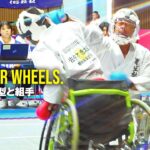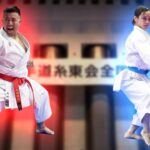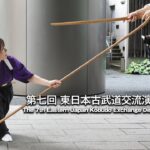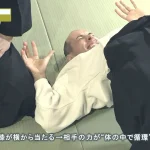text by Grigoris A.Miliaresis
I have a particular relationship with Asakusa; the culture of the Edo period is one of the reasons I am excited that I live in Japan and I feel that this culture is still alive in this particular area, from Ueno station to the Sumida River and from Minowa to Kuramae. So it was with great joy that I took the road to the Taito Riverside Sports Center for this year’s Nihon Kobudo Shinkokai Taikai, the 30th of its kind and one of the two big kobudo events in Tokyo. Luckily my school, Toda-ha Buko Ryu wasn’t going wasn’t going to demonstrate this time, so I had the opportunity to simply enjoy the demonstrations of the other schools.
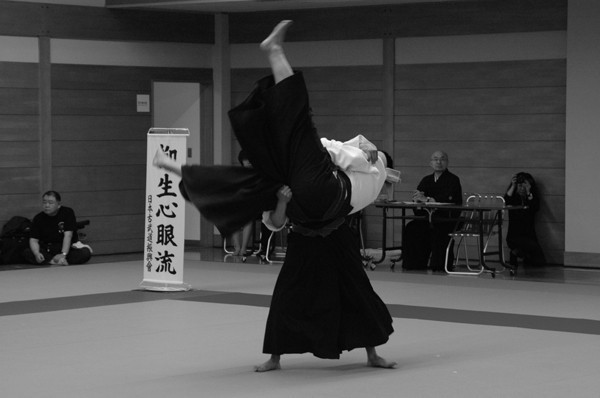
Every year, before the demonstrations begin the viewers are in for a special treat: some school gets about half an hour to present itself and to note some of the things in its curriculum that are of particular interest; this is a very useful “lesson” since even the most dedicated students of classical traditions can’t know everything about all of them! Having a school’s headmaster of senior teacher explain why their school does something in a particular way can promote better understanding of the specific school and provide the kobudo enthusiasts with insights to the school’s history and tradition. In this aspect, this year’s taikai was unique because there were not one but two such presentations: The one was from Ariwaka Shigeru sensei of Hoki Ryu Iaijutsu and the other from Hayasaka Yoshifumi sensei of the Kingai Ryu school of Okinawan karate; Hoki Ryu was supposed to do last year’s presentation but since the event was cancelled because of the earthquake, it got its chance this year instead.
The presentation of the Hoki Ryu was particularly interesting for me: even though I trained in ZNKR and Muso Jikiden Eishin Ryu iaido for eight years, I had only seen Hoki Ryu from videos; there are no Hoki Ryu dojo in Greece and very few in Europe so I was very anxious to see the school and hear about their way to do things. After the initial greeting from the Nihon Kobudo Shinkokai, Ariwaka sensei took the floor with two of his students and using them as examples, presented the four basic points of the school.
The first point he mentioned is the use of the sageo: contrary to what usually happens in ZNKR iaido and many classical schools, the Hoki Ryu practitioners don’t tie the sageo on the belt but either let it hang loose or tuck it in the side openings of the hakama. The reason for that is that if during battle the sword gets somehow lost or broken, the swordsman will immediately utilize his saya as a weapon; such a rationale certainly reflects the school’s origins, back in the Muromachi period.
The second point Ariwaka sensei pointed out was that in Hoki Ryu, the sword’s kissaki points towards the opponent’s Adam’s apple during standing techniques and in the solar plexus during seated techniques. Even though this is not exactly unique to the particular school, the Hoki Ryu’s justification is interesting: if the swordsman for some reason fails to successfully cut his opponent, he can very quickly retry a second cut whereas if the cut went further down, he would need more time. It’s interesting how outsiders rarely notice such things and even if they do, they probably don’t understand the reasoning behind it; in this case, the reasoning shows a pragmatic way of thinking that makes much sense in a realistic situation.
The third point was about Hoki Ryu’s kiai: even though the school’s two voiced (hassei) kiai, one for cutting (“iei”) and one for thrusting (“hatsu”), are most apparent, the school also uses an unvoiced, silent kiai (mussei) which is equally important. This kind of dual kiai (voiced/unvoiced) is also not unique to Hoki Ryu: having discussed the matter with various budo teachers over the years I have reached the conclusion that the voiced kiai is usually a “first step” so to speak so the practitioner can train their mind and body towards the correct attitude (mental and physical) –after that, the kiai can be silent but omnipresent in all the practitioner’s actions.
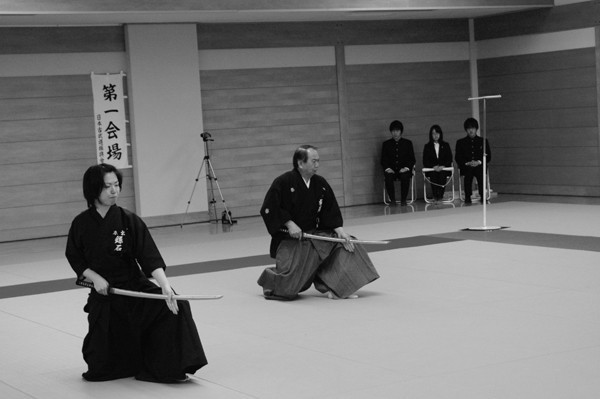
The fourth point by Ariwaka sensei was about Hoki Ryu’s chiganasi; sensei was quick to point out that the school doesn’t do chiburi like many other schools but that the practitioner’s stance (kamae) before the re-sheathing of the sword (noto) can be mistaken as such. Since the practical side of chiburi is something that has been (and still is) debated extensively, Ariwaka’s sensei remark that the Hoki Ryu practitioner sweeps the blade with a piece of paper (kaishi) and this is reflected in the way the left hand guides the sword in the saya during noto, makes perfect sense.
Besides these four main “pillars”, Ariwaka sensei pointed out a few more things regarding Hoki Ryu’s etiquette: how practitioners clap their hands before the demonstration, how they don’t separate the legs of their hakama before sitting, how they always move in 90 degrees angles (for better stability) and how they retreat at the end of their demonstration –contrary to how it’s done in ZNKR iaido and some schools, the Hoki Ryu swordsman does not do an about face but keeps walking backwards until he reaches the end of the enbujo. All these small but important details helped me (and I think all viewers) get a better understanding of a school I had heard about but never really noticed.
The second presentation was a surprise. To put it quite frankly, from the Taikai’s notes, I thought it would be one more Okinawan teacher presenting his art and even though such a presentation has some interest, it is usually quite different from my idea of Japanese kobudo. Much to my surprise, though, Hayasaka Yoshifumi sensei’s presentation was nothing like that since it focused mostly on the densho texts of various schools as well as on the weapons that many schools used both in Okinawa and in Japan.
Having studied Matayoshi Kobudo and Kingai Ryu, Hayasaka sensei became interested in the way the martial arts of Okinawa evolved; this comes as no surprise since as the founder of the system, Matayoshi Shinko (1888-1947) did extensive research in various martial arts system in Okinawa, mainland Japan and China the seeds of research and comparison are in a way “hardwired” in its core. In his research, Hayasaka sensei came across various weapons that were used both in Okinawa and Japan and started creating a theory about the influences of Japan in Okinawan arts. Conducting this research, he travelled extensively around Japan and had the opportunity to consult with headmasters of various classical Japanese traditions like Yagyu Seigo Ryu, Enmei/Niten Ichi Ryu, Toda Ryu and study their densho and his findings are going to be published soon in a book sponsored by the Nihon Kobudo Shinkoukai; needless to say that this promises to be an exciting read and personally can’t wait to see it published!
Besides the theoretical part, though, what really astounded me was the demonstration of various weapons that Hayasaka sensei has in his collection. Up to now, I had only been exposed to the “exotic” side of classical Japanese weaponry through the writings of the late Nawa Yumio (1912-2006) but like most people I didn’t have the chance to observe these weapons from close or see how they were used. Much to his credit, Hayasaka sensei tried to demonstrate as many of them as he could; highlights from his presentation include the manji sai, carried by Okinawa land inspectors as both weapons and marks of their office (pretty much in the way the twin swords were carried by Edo period samurai), the shoju bars which were hidden in the hand and could be used to enhance the fist and for applying pressure to the opponent’s pressure points, the various naeshi sticks, either as standalone or with a cord attached, the uchikama (something like a small kusarigama which was hidden inside the sleeve and could be used either like a kusarigama or as a manriki kusari), the hoken (another version of a kusarigama but with a jutte-like component on its side), the one and three pronged manriki rings (known as kakute in the Seigo Ryu vocabulary), variations of the jutte like the kusari tsuki jutte, a chigiriki with a fiercely looking ishizuki at its butt end, a unique weapon resembling a chikorigane and consisting of a bamboo stick and a treble hook but which also involves a hidden chain and can be used as a chigiriki and the torite zutsu, a weapon used to blow into the opponent’s eyes temporarily blinding him.
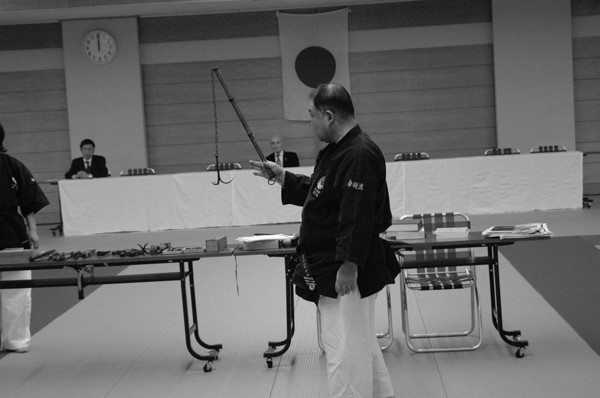
Related article:30th Asakusa Kobudo Taikai, April 2012: Under the shadow of the Sky Tree Part.2
 About the author
About the author
Grigoris Miliaresis has been practicing Japanese martial arts since 1986. He has dan grades in judo, aikido and iaido and has translated in Greek over 30 martial arts’ books including Jigoro Kano’s “Kodokan Judo”, Yagyu Munenori’s “The Life-Giving Sword”, Miyamoto Musashi’s “Book of Five Rings”, Takuan Shoho’s “The Unfettered Mind” and Donn Draeger’s “Martial Arts and Ways of Japan” trilogy. Since 2007 his practice has been exclusively in classic schools: Tenshin Buko-ryu Heiho under Ellis Amdur in Greece and Kent Sorensen in Japan and, since 2016, Ono-ha Itto-ryu under 17th headmaster Sasamori Takemi and 18th headmaster Yabuki Yuji.
http://about.me/grigorismiliaresis






